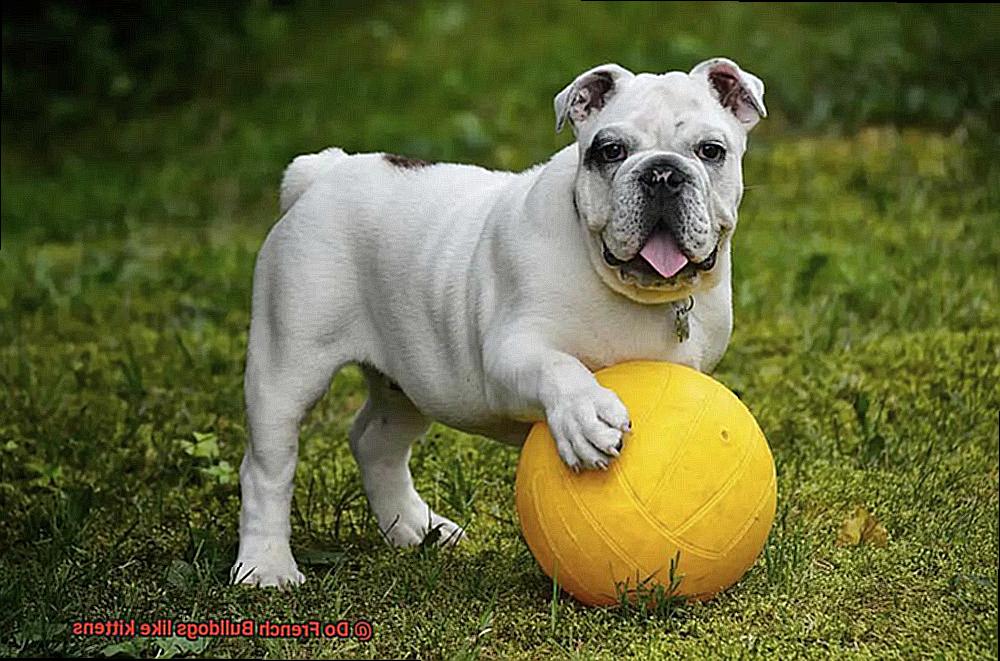Do French Bulldogs like kittens?
When it comes to adding a new member to your furry family, compatibility is key. As a devoted French Bulldog lover, you may be contemplating the age-old question: do French Bulldogs have a soft spot for kittens?
In this journey of heartwarming discovery, we’ll dive into the surprising affection that can bloom between these two adorable species. Prepare to unravel the secrets behind their compatibility and gain valuable insights on fostering a harmonious bond. Whether you’re considering expanding your pet clan or simply curious about the magic that unfolds when French Bulldogs and kittens cross paths, this blog post has got you covered.
So sit back, relax, and get ready to witness the enchanting connection shared between these pint-sized companions. It’s time to explore the irresistible charm of French Bulldogs and kittens in all its fluffy glory.
Evaluating the Temperament of French Bulldogs
Contents
French Bulldogs are beloved for their friendly and affectionate nature, making them popular pets for families. However, when it comes to introducing them to kittens, it is crucial to evaluate their temperament. In this article, we will explore the importance of assessing the temperament of French Bulldogs and provide valuable insights on how to ensure a harmonious relationship between your Frenchie and a new feline friend.
Understanding Temperament:
To evaluate a French Bulldog’s temperament towards kittens, it is essential to consider their breed characteristics. While French Bulldogs are generally good with children and other animals, each dog is unique and may have different reactions. Temperament is influenced by genetics, early socialization, and individual personality traits.
Gradual Introduction:
Introducing a French Bulldog to a kitten should be done gradually and in a controlled environment. This allows both animals to get familiar with each other’s presence and reduces the chances of any aggressive or fearful behavior. Keep the initial interactions short and positive, gradually increasing the duration as they become more comfortable.
Consider Territorial Tendencies:
French Bulldogs can be territorial, so providing them with a safe space where they can retreat if they feel overwhelmed or stressed by the presence of a kitten is important. This helps alleviate any potential conflicts and promotes a sense of security for both animals.
The Role of Socialization:
The upbringing and socialization experiences of French Bulldogs greatly impact their temperament towards kittens. Dogs that have been exposed to various people, animals, and environments from an early age are more likely to have a positive disposition towards kittens.
Supervision and Positive Reinforcement:
Supervising the interactions between your French Bulldog and kitten is crucial during the initial stages. This ensures the safety of both animals and allows for intervention if any negative behavior arises. Utilizing positive reinforcement training techniques can encourage desirable behavior from your Frenchie, reinforcing good habits and reducing the likelihood of aggression or rough play.
Seeking Professional Help:
If there are any signs of aggression or fear towards kittens, it is important to seek professional help from a dog behaviorist or trainer. They can assess the situation and provide guidance on how to address any issues and ensure the well-being of both the French Bulldog and the kitten.
The Benefits of Gradual Exposure
Introducing a French Bulldog to a new kitten can be an exciting but delicate process. To ensure a smooth transition and foster a harmonious relationship, gradual exposure is highly recommended. This method allows the animals to become familiar with each other’s presence at their own pace, reducing stress and anxiety. In this article, we will explore the benefits of gradual exposure for introducing a French Bulldog to a kitten.
Reducing Stress and Anxiety:
Gradual exposure helps minimize stress and anxiety for both the French Bulldog and the kitten. By slowly introducing them to each other’s scent and presence, it prevents overwhelming feelings and potential territorial behaviors. This gradual approach allows both animals to feel more comfortable and secure in their environment.
Building Positive Associations:
The goal of gradual exposure is to build positive associations between the French Bulldog and the kitten. By allowing them to interact in controlled environments, they can establish trust and familiarity. Positive experiences during these interactions will increase the likelihood of them getting along in the long term.
Smooth Transition:
A gradual introduction gives the French Bulldog time to adjust to the presence of the new addition. It avoids overwhelming them with sudden changes, ensuring a smoother transition for both animals. This approach allows them to establish boundaries and adapt to each other’s presence at their own pace.
Monitoring and Intervention:
Gradual exposure enables owners to closely monitor the interactions between the French Bulldog and the kitten. Being present during these interactions allows for intervention if necessary, ensuring the safety and well-being of both animals. This hands-on approach helps prevent any negative reactions or aggressive behaviors from either animal.
Individual Considerations:
It is important to remember that every dog and cat is unique, so the timeline for gradual exposure may vary. The temperament and personality of the French Bulldog and the kitten should be taken into account when planning their introduction. Patience, consistency, and positive reinforcement are crucial during this process.
Assessing the Age and Size Difference
Introducing a French Bulldog to a new kitten can be an exciting but delicate process. Understanding the age and size difference between these adorable creatures is crucial for a successful introduction and fostering a harmonious relationship. In this blog post, we will explore the key factors to consider when bringing these furry friends together, ensuring a safe and enjoyable experience for everyone involved.
Age Compatibility:
Just like humans, puppies and kittens have different energy levels and play styles at various stages of their development. If you have a young French Bulldog puppy, introducing them to a young kitten can be advantageous. They can grow up together, learning socialization skills from an early age, and building a strong bond based on trust and understanding.
However, if you already have an adult French Bulldog, it’s essential to assess how well they tolerate smaller animals. Some French Bulldogs may have a high prey drive, perceiving kittens as potential prey. In such cases, closely monitoring their interactions and seeking professional training or behavior modification techniques may be necessary to ensure a safe coexistence.
Size Difference Considerations:
French Bulldogs are generally small to medium-sized dogs, but they still have the advantage of size over most kittens, especially when fully grown. To create a secure environment for the kitten, provide elevated perches or separate rooms with baby gates that the dog cannot access. This allows the kitten to feel safe while exploring their surroundings, reducing the risk of accidental injuries during playtime.
The Importance of Supervision:
Supervision plays a vital role in assessing the age and size difference between French Bulldogs and kittens. By closely observing their interactions, you can identify any signs of discomfort or aggression from either side. If you notice growling, hissing, or excessive rough play, it’s essential to intervene and redirect their attention to more positive activities.
Training for Positive Interactions

Training your French Bulldog for positive interactions with kittens can be a rewarding and heartwarming experience. By following these steps, you can create a harmonious bond between your furry friends:
- Set the stage: Create a calm and controlled environment for the introduction. Keep both the French Bulldog and the kitten on a leash or in separate rooms initially. This allows them to see and smell each other without direct contact, reducing the chances of any aggressive behavior.
- Gradual introductions: Slowly introduce them to each other in a supervised manner. Use positive reinforcement techniques like treats and praise to reward calm and non-aggressive behavior from both the French Bulldog and the kitten.
- Monitor body language: Pay close attention to their body language for any signs of discomfort or aggression. If either animal shows signs of stress or aggression, separate them immediately and try again later. Consistency and patience are key in training for positive interactions.
- Provide separate spaces: Give both the French Bulldog and the kitten their own safe spaces to retreat to when needed. This ensures they have their own territory and reduces the chances of conflicts arising.
- Individual personalities matter: Every French Bulldog and kitten is different, so their individual personalities and temperaments may influence their compatibility. Gauge their reactions during the introduction process to ensure a positive interaction.
- Socialization is key: Expose both the French Bulldog and the kitten to various situations, people, and animals from an early age. This helps them become more adaptable and comfortable around different animals, including kittens.
Remember, seeking professional advice is always a good idea. Consulting with a professional dog trainer or behaviorist can provide valuable guidance and support in training your French Bulldog for positive interactions with kittens.
Creating a Safe Environment
Let’s dive right in.
Designated Safe Space:
Ensure that your kitten has a designated safe space where it can retreat when it needs some alone time. This area should be inaccessible to your French Bulldog and equipped with all the essentials, such as food, water, litter box, and toys.
Gradual Introductions:
Introduce your French Bulldog and kitten gradually to ensure a smooth transition. Start by allowing them to sniff each other’s scents through a closed door or gate. This helps them become familiar with each other’s presence before direct interaction.
Supervised Interactions:
When it’s time for face-to-face introductions, closely supervise their interactions initially. Keep both animals on a leash or harness to have control over their movements. This allows you to step in and redirect any unwanted behavior or prevent potential aggression.
Positive Reinforcement:
Positive reinforcement is key to creating a safe environment for both your French Bulldog and the kitten. Reward them with treats and praise when they exhibit calm and friendly behavior towards each other. By associating positive experiences with their interactions, they will learn to associate each other’s presence with positive outcomes.
Separate Resources:
Provide separate resources for both animals, including food and water bowls, beds, and toys. This prevents resource guarding behavior and ensures that both animals feel secure with their own belongings.
Exercise and Mental Stimulation:
Regular exercise and mental stimulation are crucial for both French Bulldogs and kittens. Engage them in interactive playtime sessions and provide stimulating toys to prevent boredom and redirect any potential aggressive behavior.
Individual Attention:
Give both your French Bulldog and the kitten individual attention and quality time with their respective owners. This strengthens their bond with their human companion and prevents any potential jealousy or rivalry between the two animals.
Conclusion:
Creating a safe environment for both French Bulldogs and kittens requires patience, consistency, and understanding. By following these guidelines, you can foster a positive and harmonious relationship between your furry friends. Remember, each animal is unique, so observe their reactions closely during the process. With proper introductions, supervision, and positive reinforcement, you can create a safe and happy environment for both your French Bulldog and your new kitten.
Signs of Aggression or Discomfort
French Bulldogs are known for their friendly and affectionate nature, but like any other breed, they may exhibit signs of aggression or discomfort when faced with certain situations, such as being around kittens. As a responsible owner, it is important to recognize these signs and take appropriate measures to ensure the safety and well-being of both your French Bulldog and the kitten. In this blog post, we will explore the signs that indicate aggression or discomfort in French Bulldogs when they are around kittens.
Growling:
Growling is one of the most common signs that a French Bulldog may display when feeling threatened or uncomfortable around kittens. This vocalization serves as a warning sign and should not be ignored. If your French Bulldog starts growling when near a kitten, it is important to intervene promptly and separate them to prevent any potential harm.

Body language cues:

Dogs communicate through body language, and French Bulldogs are no exception. When feeling aggressive or uncomfortable around kittens, they may display signs such as stiffening their body, raising their hackles (the hair on their back), or showing dominant postures like standing tall with their tail held high. These behaviors indicate that the dog is ready to defend themselves if necessary.
Excessive barking:
Excessive barking can also be a sign of aggression or discomfort in French Bulldogs around kittens. If your French Bulldog starts barking persistently when near a kitten, it may be an indication that they are feeling stressed or threatened. It is important to address this behavior and provide a calm environment for both animals.
Snapping or lunging behavior:
If you notice any snapping or lunging behavior from your French Bulldog towards a kitten, it is a clear sign of aggression. This action can potentially cause harm to the kitten and should be taken seriously. Immediate intervention and separation of the animals are necessary to prevent any injuries.
Overall behavior and demeanor:
Pay attention to the overall behavior and demeanor of your French Bulldog when they are around kittens. If they appear tense, anxious, or constantly on edge, it may indicate that they are not comfortable with the presence of a kitten. Respect their boundaries and provide them with a safe space away from the kitten if needed.
Professional Guidance from Veterinarians
While the dynamics between these two adorable creatures can vary, seeking professional guidance from veterinarians can greatly assist in understanding their behavior and fostering a positive relationship between them. In this blog post, we will explore the importance of professional guidance when introducing French Bulldogs and kittens, providing you with valuable insights and tips for a harmonious coexistence.
Individual Personalities Matter:
Just like humans, dogs have unique personalities that influence their reactions and preferences. Some French Bulldogs may naturally be more tolerant and accepting of kittens, while others may display reserved or even aggressive behavior. It’s essential to consider your French Bulldog’s personality when introducing a new kitten into the household.
Early Socialization is Key:
Early socialization plays a crucial role in determining how well French Bulldogs will get along with kittens. Introducing them at a young age allows them to become familiar with each other’s scents, sounds, and behaviors. This positive exposure lays the foundation for a harmonious relationship between them.
Close Monitoring of Interactions:
When introducing your French Bulldog to a new kitten, it’s important to closely monitor their initial interactions. Start with controlled, supervised meetings to ensure the safety of both animals. This allows the French Bulldog to become accustomed to the presence of the kitten and vice versa.
Seek Professional Guidance:
If your French Bulldog shows signs of aggression or discomfort towards the kitten during these initial encounters, it’s crucial to seek professional guidance from a veterinarian or an animal behaviorist. They can provide specific advice tailored to your individual situation and help address any potential issues or concerns.
Provide Separate Spaces and Resources:
To minimize conflicts over resources, it’s important to provide each animal with their personal space and resources. This includes separate feeding areas, sleeping spaces, and designated play areas. Ensuring that each animal has their own territory and belongings promotes a sense of security and reduces potential tensions.
CfUuIlVVK9I” >
Conclusion
In conclusion, the bond between French Bulldogs and kittens can be truly heartwarming and adorable. However, it is crucial to carefully assess your French Bulldog’s temperament and introduce them to a kitten in a gradual and controlled manner. Understanding their breed characteristics, considering territorial tendencies, and providing proper socialization are pivotal in fostering a harmonious relationship between these two species.
Taking things slow is highly recommended as it helps alleviate stress and anxiety for both the French Bulldog and the kitten. Allowing them to become acquainted with each other at their own pace creates positive associations and ensures a smooth transition.
When bringing a new kitten into the mix, it is essential to consider factors such as age and size differences. Assessing compatibility based on energy levels and play styles is important, while closely monitoring their interactions and providing separate spaces for each animal.
Training your French Bulldog for positive interactions with kittens is an immensely rewarding process that requires patience, consistency, and positive reinforcement. By establishing a safe environment, setting boundaries, and seeking professional guidance if necessary, you can ensure the well-being of both your French Bulldog and the kitten.
Recognizing signs of aggression or discomfort in French Bulldogs when they are around kittens is crucial for preventing potential harm. Growling, body language cues, excessive barking, snapping or lunging behavior should be taken seriously, necessitating immediate intervention.
Lastly, consulting veterinarians or animal behaviorists can offer invaluable insights tailored to your specific situation. They can help evaluate individual personalities, guide you through the introduction process, and address any concerns or issues that may arise.




